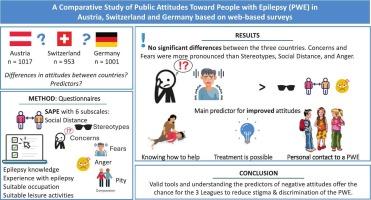A comparative study of public attitudes toward people with epilepsy in Austria, Switzerland and Germany based on web-based surveys
IF 2.3
3区 医学
Q2 BEHAVIORAL SCIENCES
引用次数: 0
Abstract
Objective
Assessment and comparison of public attitudes toward people with epilepsy (PWE) in Austria (AT), Switzerland (CH) and Germany (DE), including the identification of predictors.
Methods
Web-based surveys were conducted in all three countries using the same method of data collection, data weighting and validated questionnaires: SAPE (Scale of Attitudes toward People with Epilepsy) to assess Social Distance, Stereotypes, Personal Concerns, and Emotional Reactions, and Suitability of Professional and Leisure Activities for PWE, Epilepsy Knowledge, Experience with epilepsy, and Sociodemographic data of the respondents. For comparison with former surveys the Caveness Questions (CQ) were added. Adult respondents (≥ 18 years) who had heard of epilepsy from AT (n = 1017), CH (n = 951), and DE (n = 1001) were included.
Results
About two thirds of the population have known someone with epilepsy, around half have witnessed a seizure but less than half would know what to do during a seizure. Attitudes toward PWE were similar across the three countries and did not differ significantly (presented as mean ± standard deviation in the total group): Concerns (41.9 ± 23.2) and Fears (36.6 ± 23.9) in dealing with PWE being more pronounced than Anger (9.6 ± 17.1), negative Stereotypes (17.7 ± 18.3), and Social Distance (17.0 ± 18.6). One’s own involvement appears to be a key in reducing social distance and improving attitudes toward PWE: Personal contact with PWE, the ability to help during a seizure, and knowledge about treatment of epilepsy were the most important predictors for positive attitudes. Women reported less Social Distance and Anger than men. Only 5–7 % of the respondents considered epilepsy as insanity, but between 22–27 % would agree with at least one distancing item of the CQ. Professional activities involving dangerous situations or weapons and those involving direct responsibility for a helpless person (baby) were considered less suitable for PWE by around 40 % or more of the respondents in all three countries. However, the share of those who were uncertain about the Suitability of Occupational and Leisure Activities was quite high.
Significance
For the first time a common survey was conducted in the three German speaking countries of Austria, Switzerland and Germany with the new tool (SAPE) encompassing adapted scales on Social Distance and Emotional Reactions. The survey laid the foundation for monitoring changes in attitudes in the three countries in the long term and shows which priorities should be set for desirable joint actions by the three Epilepsy Leagues/Societies to positively influence the attitudes of the populations toward PWE.

基于网络调查的奥地利、瑞士和德国公众对癫痫患者态度的比较研究
目的评估和比较奥地利(AT)、瑞士(CH)和德国(DE)公众对癫痫患者(PWE)的态度,包括确定预测因素。方法在这三个国家采用相同的数据收集、数据加权和有效问卷调查方法进行基于sweb的调查:SAPE(对癫痫患者的态度量表)评估社会距离、刻板印象、个人关注和情绪反应、职业和休闲活动对PWE的适用性、癫痫知识、癫痫经验和受访者的社会人口统计数据。与以前的调查相比,增加了洞穴性问题(CQ)。包括有AT (n = 1017)、CH (n = 951)和DE (n = 1001)病史的成人(≥18岁)。结果:大约三分之二的人认识癫痫患者,大约一半的人目睹过癫痫发作,但不到一半的人知道癫痫发作时该怎么做。三个国家对PWE的态度相似,没有显著差异(以总组的平均值±标准差表示):在处理PWE时,担忧(41.9±23.2)和恐惧(36.6±23.9)比愤怒(9.6±17.1)、负面刻板印象(17.7±18.3)和社会距离(17.0±18.6)更为明显。一个人自己的参与似乎是减少社会距离和改善对PWE态度的关键:与PWE的个人接触,癫痫发作时的帮助能力,以及对癫痫治疗的了解是积极态度的最重要预测因素。女性的社交距离和愤怒程度都低于男性。只有5 - 7%的受访者认为癫痫是精神错乱,但22 - 27%的受访者同意CQ中至少一个距离项目。在所有三个国家中,大约40%或更多的受访者认为,涉及危险情况或武器的专业活动以及涉及对无助的人(婴儿)直接负责的专业活动不太适合PWE。然而,对职业和休闲活动的适宜性不确定的人的比例相当高。意义首次在奥地利、瑞士和德国三个德语国家进行了一项共同调查,使用了新的工具(SAPE),包括社会距离和情绪反应的适应量表。这项调查为长期监测这三个国家的态度变化奠定了基础,并显示了三个癫痫联盟/协会应确定哪些优先事项,以便采取适当的联合行动,积极影响民众对PWE的态度。
本文章由计算机程序翻译,如有差异,请以英文原文为准。
求助全文
约1分钟内获得全文
求助全文
来源期刊

Epilepsy & Behavior
医学-行为科学
CiteScore
5.40
自引率
15.40%
发文量
385
审稿时长
43 days
期刊介绍:
Epilepsy & Behavior is the fastest-growing international journal uniquely devoted to the rapid dissemination of the most current information available on the behavioral aspects of seizures and epilepsy.
Epilepsy & Behavior presents original peer-reviewed articles based on laboratory and clinical research. Topics are drawn from a variety of fields, including clinical neurology, neurosurgery, neuropsychiatry, neuropsychology, neurophysiology, neuropharmacology, and neuroimaging.
From September 2012 Epilepsy & Behavior stopped accepting Case Reports for publication in the journal. From this date authors who submit to Epilepsy & Behavior will be offered a transfer or asked to resubmit their Case Reports to its new sister journal, Epilepsy & Behavior Case Reports.
 求助内容:
求助内容: 应助结果提醒方式:
应助结果提醒方式:


